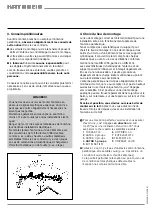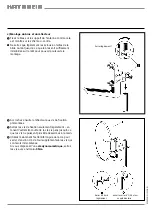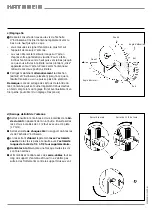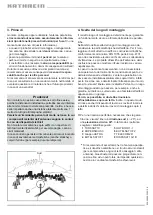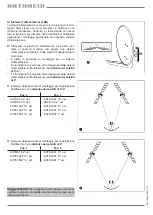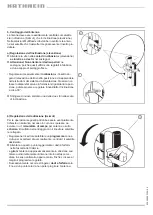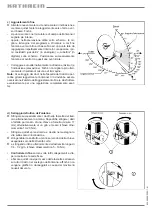
935.2098/C/1205
/8.8e/ZWT Subject to technical changes.
c) Routing of grounding conductors
Antenna cables and grounding conductors must not
be routed through rooms used for storing easily in-
flammable substances (hay or straw, for example) or in
which an explosive atmosphere can develop (gases,
vapours).
If the parabolic antenna is used in integrated antenna
systems (e. g. distribution systems), the grounding
measures must also be designed in such a way that
grounding protection is still maintained if individual
units are removed or replaced.
7. Antenna grounding / Lightning protection
The antenna must be grounded as is required by standard
DIN EN 50083-1. The only external antennas exempted
from this are those:
– fitted more than 2 metres below the crest of the roof
– whilst also less than 1.5 metres from the building.
However, for safety reasons Kathrein recommends to
mount a potential equalisation device.
Danger can arise not just from thunderstorms (lightning
strikes) but also through static charge accumulation or
discharge in the devices attached:
Consequently, the mast and the external conductor of
the antenna cable must be connected to the building’s
lightning conductor system taking the shortest path
vertically via a suitable grounding conductor (or to the
building’s grounding system if no lightning conductor
system is available).
a) Suitable as grounding conductor:
– a single solid wire with a min. cross-section of at least
16 mm
2
for copper, 25 mm
2
for aluminium or 50 mm
2
for
steel
– or metallic domestic installations (continuous metallic
water or heating system pipes, for example) provided
that they at least meet the requirements for grounding
conductors in terms of cross-section and permanence
of the electrical connection.
b) Not suitable as grounding conductor:
– the external conductors of the antenna cable
– or the grounding conductor or neutral conductor of the
power system
Attention!
Due to the danger of inadequate results from groun-
ding and lightning conductor work, only electricians
with the requisite specialised training must undertake
this!
Never undertake grounding and ligthning conductor
work yourself unless you are a specialist with the
necessary know-how!
The instructions supplied here are not an invitation to
non-specialists to take responsibility for carrying out
grounding and lightning conductor work themselves,
but serve as additional information for the specialist
engaged by them.
KATHREIN-Werke KG · Anton-Kathrein-Straße 1–3 · Postfach 10 04 44 · D-83004 Rosenheim · Deutschland · Telefon (0 80 31) 18 40 · Telefax (0 80 31) 18 43 06
Grounding
conductor
Grounding
connection
Equipotential bonding
strip
Mains
connection
230 V
Equipotential
bonding conductor
Equipotential
bonding
conductor
Equipotential
bonding strip
Grounding the antenna
installed in the hatched
area is not explicitly
required by standard.

















